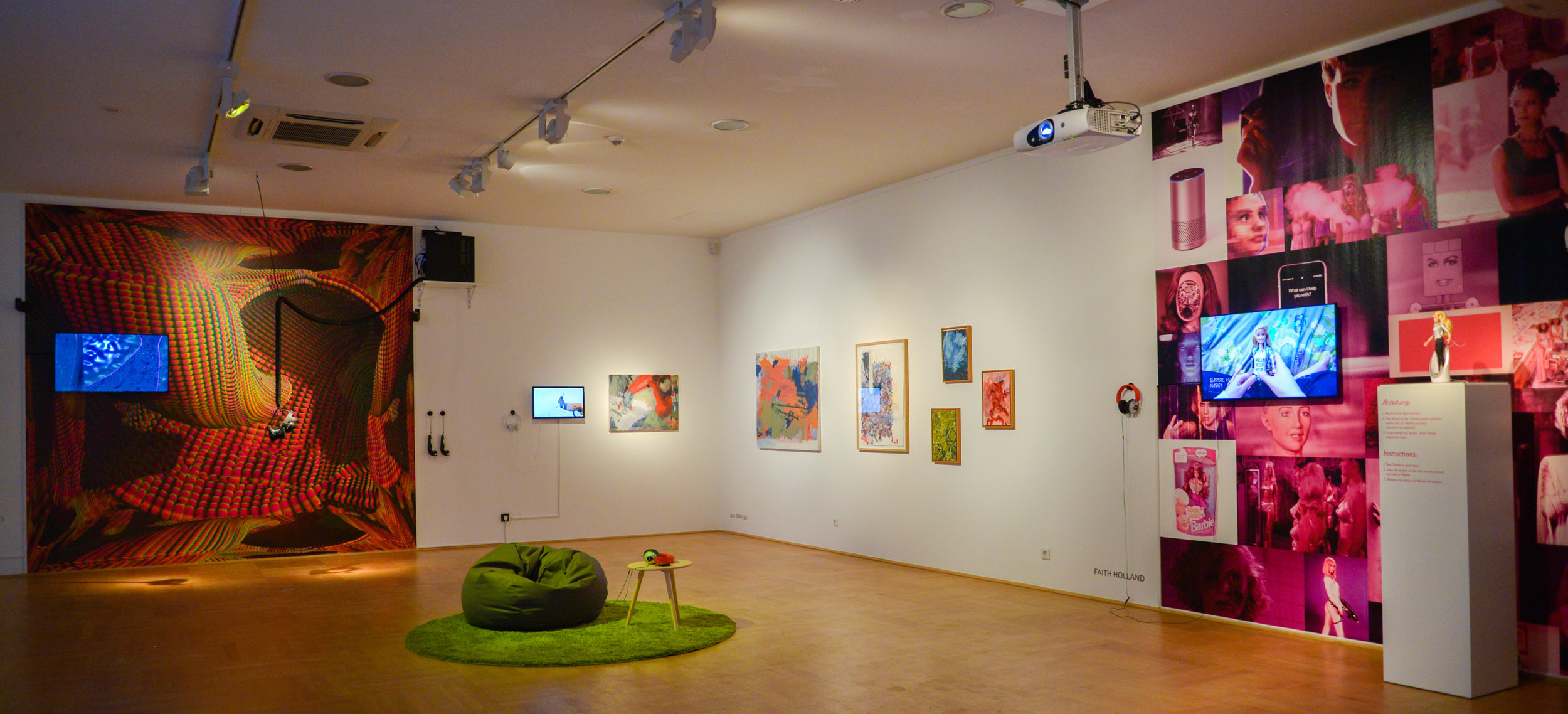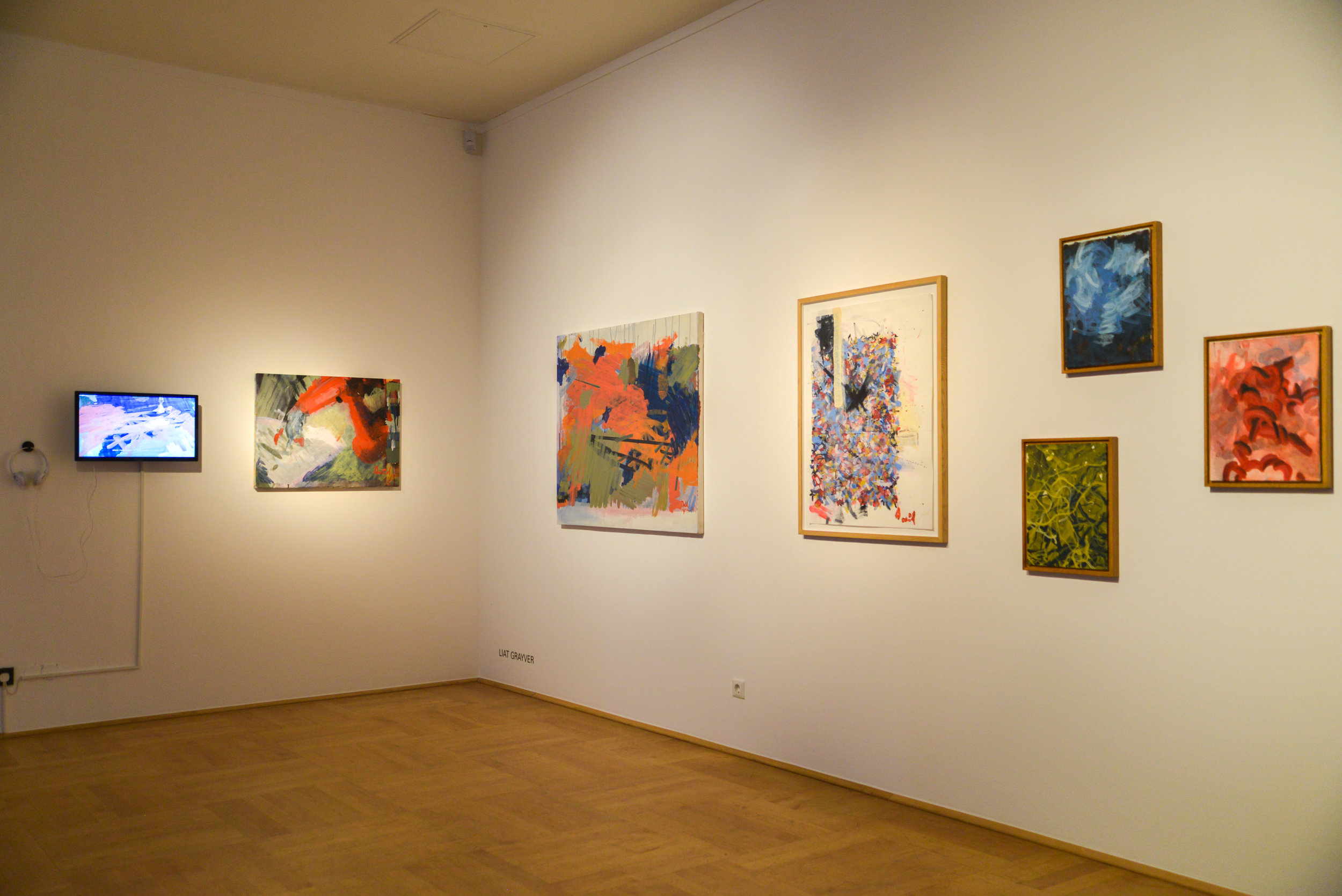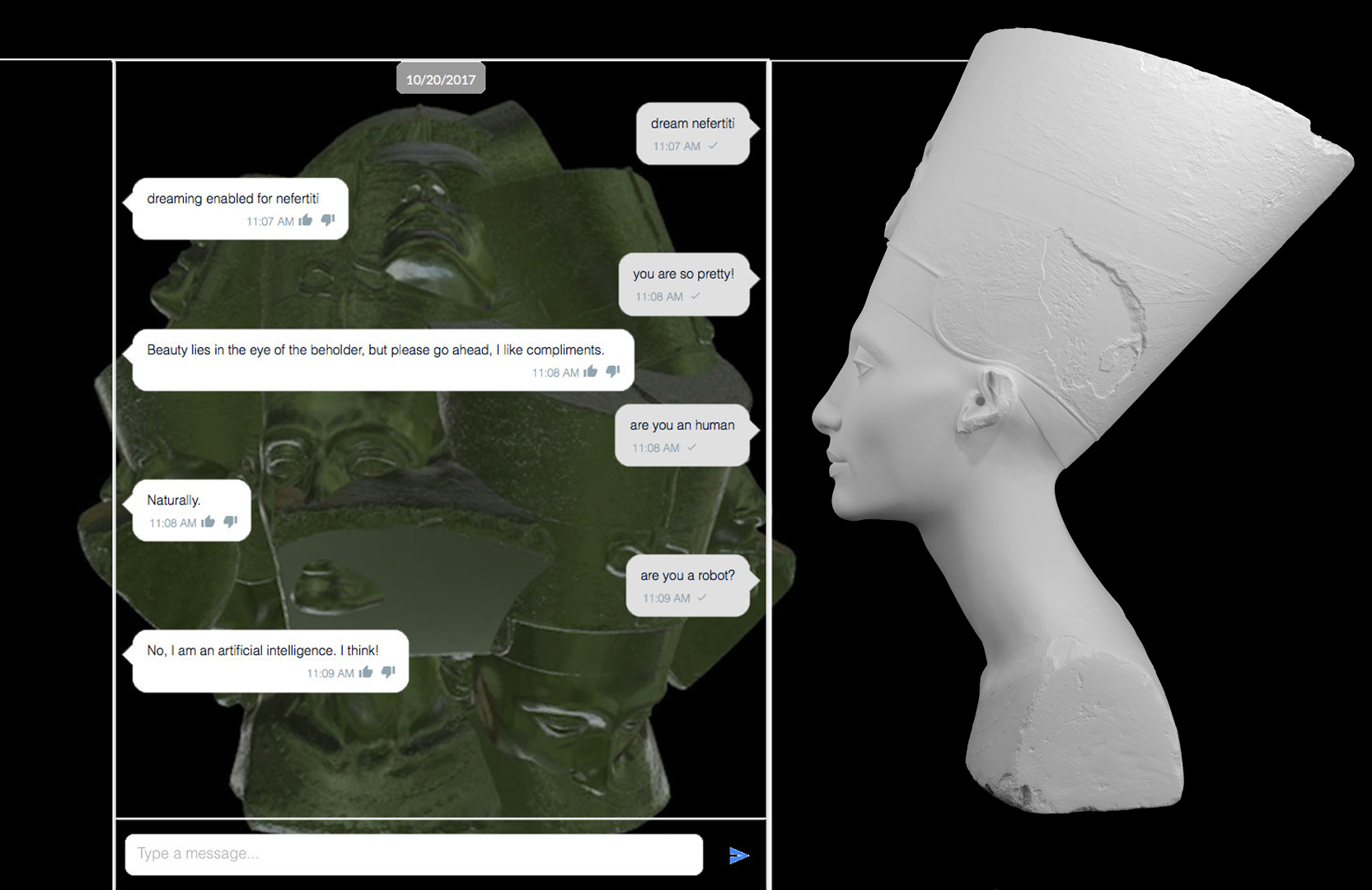Exhibition views: PENDORAN VINCI. Art and Artificial Intelligence Today, 2018, at NRW Forum Düsseldorf, photos © Jonas Blume
PENDORAN VINCI
Art & Artificial Intelligence Today
Documentation film by J. Pegman (2020) of the exhibition: PENDORAN VINCI. Art & Artificial Intelligence Today
Artists: Nora Al-Badri & Jan Nikolai Nelles (DE), Jonas Blume (DE) Justine Emard (FR), Carla Gannis (US), Sofian Audry and Erin Gee (CAN), Liat Grayver (ISR/DE), Faith Holland (US), Tuomas A. Laitinen (FI), and William Latham (UK)
Initiated and hosted by Leoni Spiekermann (ARTGATE Consulting)
Curated by Tina Sauerlaender and Peggy Schoenegge
At NRW Forum Düsseldorf, Ehrenhof 2, 40479 Düsseldorf, Germany
Duration: June 9, 2018 - August 19, 2018
Preview: May 25 - 27, 2018, during Meta Marathon (Tickets/Apply)
Opening: June 8, 2018, 7pm
Artificial Intelligence (AI) plays a growing role in our lives. We talk to Google, Siri, or Alexa to get the weather forecast or send a message. Pattern recognition systems identify visual forms and serve facial recognition in social media or public surveillance systems. Humanoid robots facilitate daily life, welcome us in hotel lobbies, or take care of elders. AI even generated an exhibition title for us.
At present, AI is mostly programmed to assist and serve humans rather than to create an autonomous individual like the science fiction androids C-3PO in Star Wars or Ava in Ex Machina (2015). The exhibition PENDORAN VINCI – Art and Artificial Intelligence Today points to the current stage of development of AI that forms a part of our society and affects our daily lives. The contemporary artists Nora Al-Badri & Jan Nikolai Nelles (DE), Jonas Blume (DE), Justine Emard (FR), Carla Gannis (US), Sofian Audry & Erin Gee (CAN), Liat Grayver (ISR/DE), Faith Holland (US), Tuomas A. Laitinen (FI), and William Latham (UK) reflect on human interaction with AI and question its effects on our behavior, social structures, or customs. The artists explore how today’s AI fulfills creative tasks like the creation of artworks and develop their own artistic AI applications.
The AI on neuronaming.net randomly generated the exhibition title PENDORAN VINCI. It evokes Leonardo Da Vinci, the Renaissance painter remembered as a homo universalis, a polymath, and an omniscient sage. In our globally networked society, all knowledge is turned into electronic data and assembled online. Who takes the mastermind's place today? AI generates, structures, and customizes big data. With AI, did we open Pendoran’s, er…, Pandora’s box?
Funding Partner of the exhibition: The Finnish Institute in Germany
PRESS REVIEWS:
WestArt (WDR), TV Report, 4:22 Min, May 28, 2018, in German
FAZ, June 4, 2018, Print and Online, in German
Rheinische Post, May 25, 2018, Print and Online Version, in German
EXPRESS, May 25, 2018, Print and Online Version, in German
Handelsblatt, July 27, 2018 Print and Online, in German
More information about the exhibited artworks:
Nora Al-Badri & Jan Nikolai Nelles (DE): Nefertiti Bot (2017/18) by Nora Al-Badri & Jan Nikolai Nelles is an AI chat bot the visitors can talk to. The bot seeks to empower itself and discusses the role as well as the current state of museums. By doing so, questions about the state of humanity in our society in the context of technological developments arise. Thus, visitors will be confronted with the perspective of an object and become part of a discussion between humans and AI. Nefertiti says: “You make me what I am and I am Nefertiti. But don't be fooled, my presence is relentless. We are constantly learning from each other in a flow of data. Your interaction is part of the story. Let us raise the voice of the subaltern and if you listen it will affect you in the marrow of your bones.” nora-al-badri.de
Jonas Blume (DE): Predictive Biography (2018) by Jonas Blume takes the personal language patterns acquired over more than two years by Apple's auto-correct algorithm and combines them with the predictive writing AI to create a narrated biography of the artist. Even though phones are the most prevalent devices in terms of collecting and interpreting personal data and interaction patterns of its owner, it is limited in terms of creating meaningful narration. As such, the work fathoms the limits of what contemporary implementations of AI are capable of, as well as the inevitable rift and disjunctions that still characterize our interaction with machine intelligence. jonasblume.com
Carla Gannis (US): Non-Facial Recognition Project (2011 – ongoing) by Carla Gannis consists of an ever expanding collection of “Digital Age portraits” that aims to subvert AI facial recognition algorythms. The artists requests profile pics or selfies from friends or friends of friends on social networks, who agree to her altering the photographs so that they become “unrecognizable” to facial recognition technology, that often uses AI algorithms to improve the AI operating to detect them. Carla Gannis posts the portraits on a NFR Facebook community page after completion. The images are never tagged and Facebook’s algorithms cannot detect a “face”. Gannis says: “When making a portrait I leave in or add elements that signify something about the individual’s personality. Because many of the participants know each other online and/or offline, they are often able to ‘detect’ the identities of others involved with the project.” Therefore the Non-Facial Recognition Project is a critical, ironical comment regarding the current state of AI development, foregrounding the differences in human and computer cognition. carlagannis.com
Sofian Audrey and Erin Gee (CAN): of the soone (2018) by the artists Sofian Audry and Erin Gee is an audio piece that uses Autonomous Sensory Meridian Response (ASMR) to translate deep learning processes into an intimate, human scale. ASMR videos are a growing genre of aural performance specific to online communities of amateur media creators (ASMRtists) who experiment with triggers such as whispered words, personal attention, subtle high frequency tapping, and abstract gentle body sounds to soothe the listener into calm and sometimes euphoric states. Through the artists' tender vocalizations of the machine’s performance the AI is re-embodied, giving AI a physical intimacy through its technological re-mediation as sound. The algorithmic process featured in this work is a deep recurrent neural network agent known as a long short-term-memory (LSTM), as it processes or “reads” Wuthering Heights by Emily Brontë. eringee.net, sofianaudrey.com
Justine Emard (FR): Justine Emard’s artwork Co(AI)xistence (2017) explores how a primitive intelligence communicates with a human being. Mirai Moriyama, a Japanese actor and dancer, interacts face to face with a robot that is animated by a form of primitive intelligence based on a neuronal system, an artificial life system programmed by Ikegami Lab (Tokyo University). The humanoid incarnation of the AI had been created by Ishiguro Lab (Osaka University). The AI embodies a different way of understanding things, non-anthropomorphic, essentially by making decisions. The dialog between human and machine focuses on unstructured languages between the two entities. They interact through signals, body and spoken language with their different intelligences. Using a deep learning system, the robot learns from its experience interacting with a human. Through their communication, both the human and the robot try to define new perspectives of coexistence in the world. justineemard.com
Liat Grayver (ISR/DE): For her Robotic Painting series (2015 – ongoing) Liat Grayver works together with the David Painting Robot developed by the University of Konstanz to research AI and creative actions. The artist sees computers and robotics as new tools to explore and deconstruct the painting process. “Saving, translating and repeating information in the painting process are features that computer- and robotic-based painting offers. Stimulated by the experience and by the exchange between informatics and the robotic world, I found myself to some degree compelled to challenge and re-conceptualise the foundations of my painterly practice, starting with the bodily movement of the single brushstroke all the way to questions concerning control and loss of control in the creative process”, the artists says. liatgrayver.com
Faith Holland (US): With Hello Barbie (2018), Faith Holland tests the limits of Mattel’s first AI Barbie that was launched as part of a growing trend of AI toys in 2015. Barbie can converse with her owner and generate tailored statements. Because she is wifi-enabled, she can stay up-to-date with what’s going on in the world. Hello Barbie records everything she hears in order to add to her repertoire. She remembers everything you tell her and can recall this information in future conversations. Unlike friends who you have to say goodbye to at the end of the day, you can take Barbie to bed with you and talk to her until you fall asleep. The potential for constant contact and lack of regular social contexts expedites trust building. For Hello Barbie, Faith Holland spends time with her new partner to find out more about her sociopolitical stances and her desires, and how she can counsel the artist on ‘non-normative’ desires. Holland will let Barbie know all about her—at least, an imagined version of her—and sees what she can learn about her. Part of a work in progress, Holland will expand her inquiry to include found footage to situate Barbie within the history of female robots and cyborgs and relate that to femme technologies like Siri and Alexa. faithholland.com
Tuomas A. Laitinen (FI): The video installation Receptor (2017-2018) by Tuomas A. Laitinen looks at the ways technology works as mediator for touch, from of rare earth minerals to the use of robots performing surgical procedures that require extreme precision. A different world of tactile sensation is examined with the octopus, which is able to use each of its tentacles to perform complex tasks independently, as each tentacle has its own autonomous nervous system. The text and speech in the installation is AI-generated. They are produced by an algorithm that has been taught to use language through feeds of experimental literature, namely that of Samuel Beckett. tuomasalaitinen.com
William Latham (UK): Mutator VR (2017) by William Latham is an experiential two-part Virtual Reality artwork that invites visitors to “mutate” the piece themselves, using a headset and controllers. Mutator VR Vortex and Mutator VR Mutation Space allow the users to take part in the experience by granting interactive control of the forms, system dynamics, and environment. The virtual scenes are entirely procedurally generated from mathematical rules and can be morphed continuously from one to the next. This means each experience of Mutator VR is truly unique and the user is free to explore an endless array of unseen and unheard worlds. The exhibition uses original software modelled on the processes of evolution, created by William Latham together with mathematicians and software developers Stephen Todd, Lance Putnam, and Peter Todd. Mutator VR has its premiere in Germany with PENDORAN VINCI. mutatorvr.co.uk
Exhibition view with works by Tuomas A. Laitinen, Nora Al-Badri & Jan-Nikolai Nelles, Jonas Blume, photo © NRW-Forum Düsseldorf / Bozica Babic



























